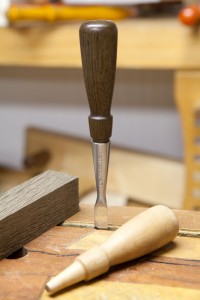We may receive a commission when you use our affiliate links. However, this does not impact our recommendations.
Exotic woods don’t blow my skirt/kilt/skort up much.
In small doses they can look beautiful, but for the most part I find them oily, difficult to work and far too wild looking for full-size furniture. I’ve always preferred hardwoods and softwoods from the Northern hemisphere. Quartersawn beech is exotic to me. Quartersawn sycamore is too wild for my potato-flake tastes.
When I was teaching in Germany this summer, two very talented students from Denmark brought me a small gift – oak that had been buried in a bog for 3,000 or so years.
It was like no other oak I’d ever seen. It was dark through and through, with light-colored medullary rays. The two chunks weren’t heavy at all; they were about as heavy as pine. Even in the rough, the stuff is beautiful.
So I gave away a good deal of my clothing (and my running shoes) so I could make room for these ancient hunks in my luggage. Since I came back from Germany in June, the wood has been sitting next to my desk – never out of sight.
Now one of the perils of teaching (and taking) classes is that sometimes your tools get swept up into other people’s bags. This is exacerbated because I freely loan all my tools to students so they can feel how a sharp tool works.
I’ve lost a few tools over the years as a result, even though I mark them all with my name.
So this summer I decided to make some special tools using this black oak. I don’t have much, but I am going to try squeeze out a set of chisel handles, a Roubo try square and winding sticks from my stock. Today I started on the chisel handles.
This oak is remarkable. It cuts beautifully – even machine tools leave a nice finish. And as far as I can tell, it has no odor. This is something I was really worried about after Glen Huey worked with some mahogany that had been buried in a jungle riverbed. It was beautiful, but it smelled like an abandoned park restroom stall.
I finished the first chisel handle this evening with a little wiping varnish and it polished up nicely. I cannot wait to cut into the rest of the stuff.
— Christopher Schwarz
Want to Learn to Turn? This summer I have been doing a lot of turning in my spare time. The biggest help to me has been the book “Elementary Turning” that we published earlier this year. It’s a great little textbook and has lots and lots of useful lessons. I highly recommend it.
Here are some supplies and tools we find essential in our everyday work around the shop. We may receive a commission from sales referred by our links; however, we have carefully selected these products for their usefulness and quality.












Hi Chris.
The handle looks superb, and “as smooth as a nuns stomach”..
I will tell my dad to go and check it out, I am sure he will agree.
By the way, I proudly wear the “divided we stand” T-shirt as often as possible, even though nobody has a clue to what it means.
to “tpobrienjr”, I have tried to use elm for chisel handles, and it worked fine, I mounted a ring on top of the handles, but I think that it would work without it.
Brgds Jonas
What about elm? I haven’t used any for tool handles, but it is reputed to have twisty grain that won’t split, which would seem to make it good for struck handles.
Hmmm – Some of your blog readers may be interested in something even more prehistoric – Kauri from New Zealand:
http://www.ancientwood.com/
The last time these trees saw sunlight, Neanderthals were still the dominant human species in Europe….
I’m curious to see how durable it is after all these years. Keep us posted.
Chris,
I love using bog oak in small amounts on boxes. It goes well with the whole “reclaimed woodworking” theme. Reclaimed white oak from the family farm and reclaimed bog oak from England or Ireland. I recently found a guy in Illinois who has a small amount of bog oak from Missouri of all places, so I might see about grabbing a couple of pieces of that. An oak box made from all reclaimed wood from Missouri definitely has an appeal to me.
Those are some nice pieces you have there. I don’t often see it that thick (6/4?) without some shake in the middle. Your German friends must like you a lot!
Nice handle. I will be curious to see how the oak compares to the ironwood with repeated strikes. I think the readers would enjoy seeing a video clip of the turning progression from stock to finished and fitted handle. I have often though about replacing my handles in the LN, but was unsure of how to exactly get the right taper into the socket. Thanks
Very nice. I had bought a lot of unhandled carving tools a while back, and enjoyed using bits of odd wood to make handles. It’s a great opportunity to work with species I otherwise would never use. Olive wood smells so wonderful, I could make shavings from it all day long.
Steve S. passed around some bog oak veneer at WIA. Beautiful stuff.